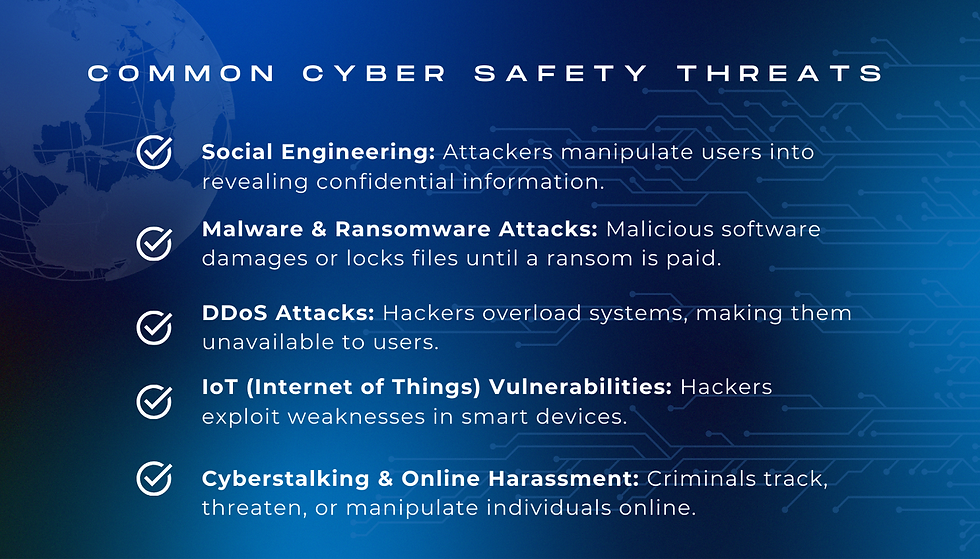
RUST COLLEGE HAS PARTNERED WITH NISSAN TO CREATE THE NISSAN-RC CYBERSECURITY SIMULATION LAB
The 7 Pillars of Cybersecurity
The 7 Pillars of Cybersecurity:
Protecting Your Digital World In order to understand cybersecurity let's first dive into the security framework that can help strengthen your digital protection.This security framework, which is known as "CIANA + PS" covers seven key areas:

These principles ensure that information remains secure, reliable and accessible. Let's break this down a little bit further and begin with what is known as the CIA triad. The CIA Triad is a foundational model in cybersecurity that represents the three core principles of information security: Confidentiality, Integrity, and Availability.
The CIA Triad: The Foundation of Cybersecurity
The CIA Triad is a security model designed to guide policies for information security within organizations.It consists of three key principles:
1. Confidentiality:
Protecting Data from Unauthorized Access Definition: Confidentiality ensures that sensitive information is only accessible to authorized individuals. It prevents unauthorized users, hackers, or insiders from accessing or disclosing data.
Key Strategies to Maintain Confidentiality:
Real-World Example:
Online banking platforms use encryption and MFA to ensure only the account holder can access their financial data.
2. Integrity: Ensuring Accuracy & Trustworthiness of Data Definition:
Integrity ensures that information remains accurate, complete, and unaltered unless modified by authorized individuals. It prevents unauthorized modifications, whether intentional or accidental.
Key Strategies to Maintain Integrity:
Real-World Example:
When you download software, integrity checks ensure that the file hasn’t been tampered with by hackers.
3. Availability: Ensuring Reliable Access to Data & Systems Definition:
Availability ensures that data and resources are accessible when needed, without disruption from cyber threats, hardware failures, or other interruptions.
Key Strategies to Maintain Integrity:
Real-World Example:
Cloud storage services (like Google Drive) use backup servers to ensure files remain available even if one data center fails.

By implementing the CIA Triad, businesses and individuals can strengthen cybersecurity and protect critical information from evolving threats.
Now let's move on to Nonrepudiation and Authentication. In cybersecurity, Non-Repudiation and Authentication are critical security principles that help ensure data integrity, accountability, and trust in digital transactions. Let’s break them down in detail:
4. Non-Repudiation: Ensuring Accountability in Digital Actions Definition:
Non-repudiation is a security principle that prevents an entity (user or system) from denying their actions or transactions after they have taken place. It ensures that there is undeniable proof that an action was performed by a specific entity.
How Non-Repudiation Works:
Non-repudiation is achieved through digital evidence that links actions to users, preventing them from falsely claiming they did not perform a specific transaction.
Key Mechanisms for Non-Repudiation:
Real-World Example:
Imagine an employee digitally signs a financial report before submitting it. If a dispute arises later, the digital signature proves that they were the author and cannot deny submitting it.
5. Authentication: Verifying Identities Before Granting Access Definition:
Authentication is the process of verifying the identity of users, devices, or systems before granting them access to resources. It ensures that only authorized individuals can interact with a system.
Types of Authentication:
Authentication is generally classified into three categories:
-
Something You Know (Knowledge-Based Authentication) Requires users to provide information only they know. Examples: Passwords, PINs, security questions.
-
Something You Have (Possession-Based Authentication) Uses a physical device or token to verify identity. Examples: Smart cards, OTPs (one-time passwords), authentication apps, security tokens.
-
Something You Are (Biometric Authentication)Uses unique biological traits for verification. Examples: Fingerprint scanning, facial recognition, retina scanning.

Real-World Example:
When logging into an online banking app, you might enter your password (something you know) and then receive a one-time code (OTP) on your phone (something you have) to confirm your identity.

By implementing Non-Repudiation and Authentication together, organizations can create a secure, verifiable, and tamper-proof environment for their digital operations.
Let's not forget the importance Privacy and Safety. In the digital world, Privacy and Safety are critical aspects of cybersecurity that protect individuals and organizations from threats such as data breaches, identity theft, and cyberattacks. While privacy focuses on controlling access to personal data, safety ensures that users remain protected from harm in online and digital environments. Let’s explore both concepts in detail.
6. Privacy: Controlling Access to Personal and Sensitive Information What is Privacy?:
Privacy refers to the right of individuals and organizations to control their personal data, ensuring that information is only shared with authorized parties. It involves protecting sensitive details such as names, addresses, social security numbers, financial records, and medical history.
Key Principles of Privacy (Fair Information Practices – FIPPs):
✔ Data Minimization: Collect only the necessary data.
✔ Purpose Limitation: Use data only for the intended purpose.
✔ Consent & Control: Users should have control over their information.
✔ Transparency: Organizations must disclose how they handle data.
✔ Security & Protection: Data must be safeguarded from unauthorized access.

Real-World Example:
The Facebook–Cambridge Analytica scandal exposed how millions of users' personal data were collected without consent and used for political profiling. This incident raised global concerns about data privacy and regulation.
7. Safety: Protecting Users from Cyber Threats and Digital Harm What is Safety in Cybersecurity?
Safety focuses on protecting individuals, organizations, and systems from cyber threats, digital manipulation, and malicious activities. It involves safeguarding both physical and psychological well-being from digital risks.
Key Elements of Cyber Safety:
✔ Safe Online Behavior: Educating users about risks and safe browsing practices.
✔ Protection from Cyberbullying & Harassment: Ensuring digital spaces are free from threats.
✔ System & Network Security: Keeping devices and networks protected from intrusions.
✔ Resilience Against Attacks: Developing strategies to recover from cyber incidents.

Real-World Example:
In 2021, a ransomware attack on Colonial Pipeline led to fuel shortages across the U.S. The attackers exploited a weak password, disrupting critical infrastructure and demonstrating the importance of strong cyber safety practices.

Final Thoughts
Privacy and safety are essential in today's connected world, where cyber threats are constantly evolving. By adopting privacy-conscious behaviors and implementing strong safety measures, individuals and organizations can reduce risks and maintain control over their digital lives.


















